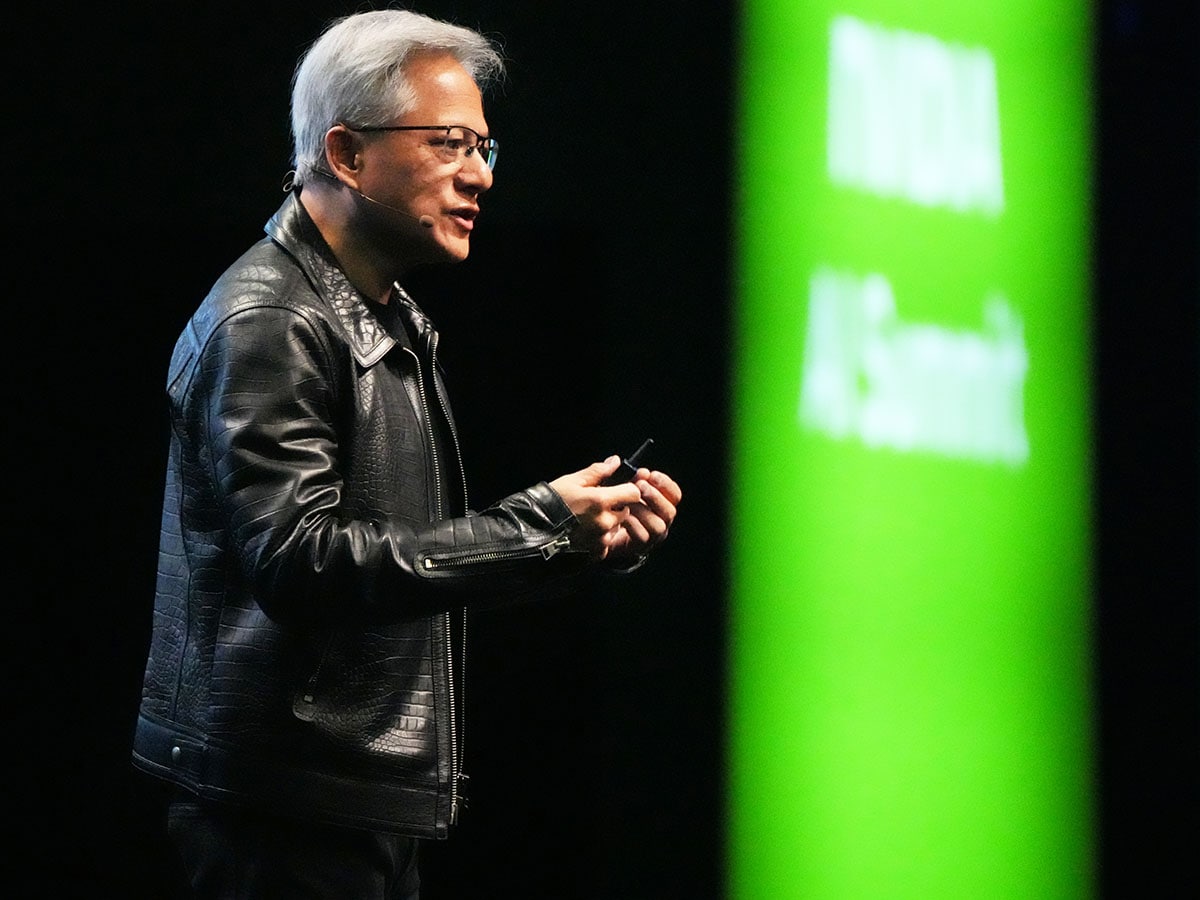 Jensen Huang, co-founder and CEO of Nvidia. After a whirlwind tour from California to Orlando to Denmark, Jensen Huang, co-founder and CEO of chip powerhouse Nvidia, took the stage at the Jio World Convention Centre soon after landing in Mumbai on October 24. He was in Mumbai for Nvidia’s first ever AI summit in India. Despite his evident fatigue—courtesy of just a few hours of sleep—Huang’s energy electrified the packed room. Dressed in his uniform black biker jacket, the 61-year-old electrical engineer captivated the tech enthusiasts, government officials, and entrepreneurs present with his keynote address.
Jensen Huang, co-founder and CEO of Nvidia. After a whirlwind tour from California to Orlando to Denmark, Jensen Huang, co-founder and CEO of chip powerhouse Nvidia, took the stage at the Jio World Convention Centre soon after landing in Mumbai on October 24. He was in Mumbai for Nvidia’s first ever AI summit in India. Despite his evident fatigue—courtesy of just a few hours of sleep—Huang’s energy electrified the packed room. Dressed in his uniform black biker jacket, the 61-year-old electrical engineer captivated the tech enthusiasts, government officials, and entrepreneurs present with his keynote address.
The three-day event also saw the CEO in conversation with Reliance Industries’ Mukesh Ambani where the two announced Reliance and Nvidia’s partnership to develop AI infrastructure in India, building on their previous collaboration announced in September last year. The duo aims to create India’s own large language model, trained on the nation’s diverse languages and tailored for generative AI applications.
Nvidia will start an innovation centre for Reliance engineers to leverage Nvidia’s technology. “We will also create applications that Reliance could offer Indian consumers. There are going to be three layers: The infrastructure layer, the technology layer and the AI application layer,” said Huang.Nvidia also unveiled a streamlined artificial intelligence model for Hindi language, one of India’s most spoken languages, aiming to expand its reach in the region. Furthermore, the company has formed partnerships with Reliance and Tata Group to build AI data centers.
The chip giant has over the last one year announced several partnerships to expand its presence in India’s growing AI market. The company plans to assist Tech Mahindra in developing a Hindi large language model and collaborate with Flipkart on conversational customer service.
A number of Indian firms, including Tata Consultancy Services (TCS), Infosys, L&T Technology Services (LTTS), and Zoho Corporation, too announced collaborations with Nvidia. TCS’s Nvidia Business unit will design and deliver curated AI adoption strategies for industries such as manufacturing, banking, financial services & insurance (BFSI), telecom, retail, and automotive.
Sridhar Vembu’s Zoho Corp plans to leverage Nvidia’s AI accelerated computing platform, including Nvidia NeMo, to build and deploy large language models (LLMs) in its software-as-a-service (SaaS) applications, it said in a press release. Zoho has already invested over $10 million in Nvidia’s AI technology and GPUs and plans to double this investment in the coming year.
Tata Communications too announced its AI Cloud infrastructure in partnership with Nvidia, with the first phase set to launch by the end of this year. This collaboration will make Tata Communications one of the largest Nvidia Hopper GPU cloud-based supercomputers in the country. Experts point out that these partnerships underscore Nvidia’s commitment to India’s burgeoning AI ecosystem, enabling innovative solutions and driving growth across industries.
Later, at a press meet, Huang also spoke about India’s IT industry, renowned for its scale and computer science expertise. “Few countries possess this valuable resource. Over the past couple of years, we’ve collaborated to upskill and upscale approximately 200,000 IT professionals in AI,” adding, “We’re building large-scale AI computing infrastructure.”
US sanctions have made it harder for Nvidia to sell its most powerful chips to China, one of its biggest markets, says Winston Ma, adjunct professor at NYU School of Law. “As the world’s largest digital economy after the US and China, India may provide much-needed AI chip demand for Nvidia to support its tremendous business growth.”
Most artificial intelligence (AI) models, including large language models (LLMs) and autonomous driving systems, rely on Nvidia hardware for training. As one of only four companies worldwide valued over $2 trillion, alongside Microsoft, Apple, and Alphabet, Nvidia’s California-based operations have witnessed a significant surge in stock market value. This growth is driven by demand for its cutting-edge technology, which enables today’s artificial intelligence through innovative hardware and software solutions.
Founded in 1993 by Jensen Huang, Chris Malachowsky, and Curtis Priem, Nvidia has evolved significantly from enhancing video game graphics to leading the next AI revolution. Nvidia’s dominance in AI hardware is evident, with its GPUs powering over 80 percent of the world’s AI computations. Notably, Nvidia heavily relies on Taiwan Semiconductor Manufacturing Company (TSMC) to manufacture its chip designs, as no other manufacturer possesses the requisite expertise for mass production. The company’s two-decade collaboration with TSMC ensures the production of high-performance chips, further solidifying its position in the AI market.
Nvidia’s latest Blackwell chips recently encountered a delay due to design flaws, but the issue has been resolved with TSMC’s assistance, Huang told Forbes India. “It was 100 percent Nvidia’s fault, but TSMC still marshalled tremendous resources to help us recover, and now we’re back in full production,” he acknowledged. Huang emphasised the importance of diversity and redundancy in Nvidia’s operations. “Passing orders to other foundries is an option,” he said, referencing Samsung and Intel. “We’ll continue to evaluate them, but it’s essential to recognise that TSMC is truly extraordinary and a special company.”
